COMMENT OF THE DAY: WHEN THEY RAISED GREAT GRANNY’S 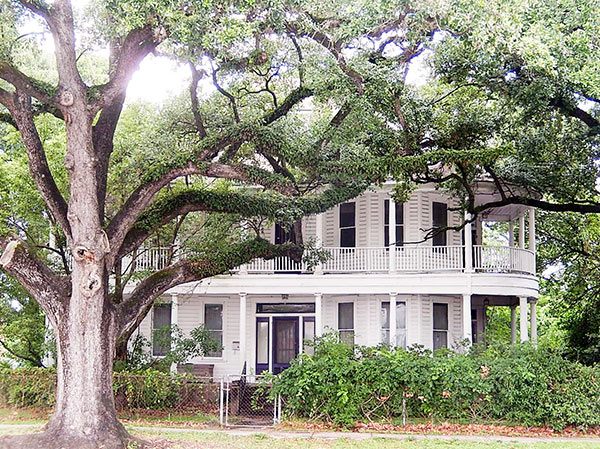 “This house has some wonderful history. It was originally a one story that was raised up by cranes and the ground level story was built underneath. During WW One, they would roll up the rugs and host dances for the soldiers. It was the home of my great grandparents who lived there with their children when they moved from PA. My two spinster Great Aunts lived there all their lives. It broke the hearts of the family when it had to be sold but no one had the means to buy and restore it. I wanted to share for those of you that had posted the kind comments.” [Renee Lauckner, commenting on Corner Lot Hidden Away for Decades Beneath 1904 Heights House Could Join the Commercial Crowd] Photo: Swamplot inbox
“This house has some wonderful history. It was originally a one story that was raised up by cranes and the ground level story was built underneath. During WW One, they would roll up the rugs and host dances for the soldiers. It was the home of my great grandparents who lived there with their children when they moved from PA. My two spinster Great Aunts lived there all their lives. It broke the hearts of the family when it had to be sold but no one had the means to buy and restore it. I wanted to share for those of you that had posted the kind comments.” [Renee Lauckner, commenting on Corner Lot Hidden Away for Decades Beneath 1904 Heights House Could Join the Commercial Crowd] Photo: Swamplot inbox
Quicklink
THE UNDERAPPRECIATED RICHES OF HOUSTON’S ANTIQUE SET 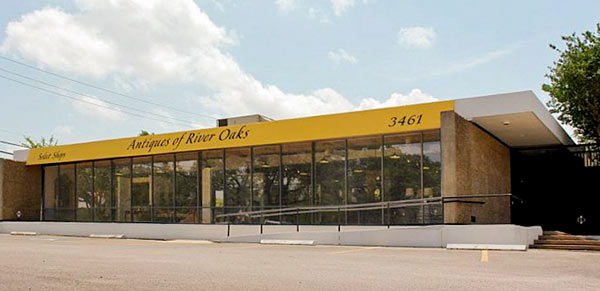 “Someday,” antique dealer and appraiser David Lackey muses to intrepid radio reporter Allison Lee, “the Millennials . . . may be horrified when their children want mahogany furniture and doilies and figurines.” But for now, Lackey seems resigned to the great generational decline — and accompanying price drops — in the market for antique furniture: “There are half as many antique shows in Houston as there were 20 or 30 years ago,” he tells Lee. “Traditional English and American furniture, overall, has fallen maybe 50 to 75 percent.” Lackey operates his business out of the Antiques of River Oaks antiques megashop (pictured above) in the home-furnishings-themed shopping center at 3461 W. Alabama north of Greenway Plaza, but he’s also out and about, soaking up the zeitgeist: “I go into more estates — or I’m working with older people and they’re selling a lot of their stuff because they say their kids and grandkids do not want it. They’ve made it very clear. The younger generation, for the most part, is not very interested in formal candlelight suppers. They don’t want silver, china, crystal, because they don’t intend to entertain that way.†[Houston Public Media] Photo: David Lackey Antiques & Art
“Someday,” antique dealer and appraiser David Lackey muses to intrepid radio reporter Allison Lee, “the Millennials . . . may be horrified when their children want mahogany furniture and doilies and figurines.” But for now, Lackey seems resigned to the great generational decline — and accompanying price drops — in the market for antique furniture: “There are half as many antique shows in Houston as there were 20 or 30 years ago,” he tells Lee. “Traditional English and American furniture, overall, has fallen maybe 50 to 75 percent.” Lackey operates his business out of the Antiques of River Oaks antiques megashop (pictured above) in the home-furnishings-themed shopping center at 3461 W. Alabama north of Greenway Plaza, but he’s also out and about, soaking up the zeitgeist: “I go into more estates — or I’m working with older people and they’re selling a lot of their stuff because they say their kids and grandkids do not want it. They’ve made it very clear. The younger generation, for the most part, is not very interested in formal candlelight suppers. They don’t want silver, china, crystal, because they don’t intend to entertain that way.†[Houston Public Media] Photo: David Lackey Antiques & Art
HOUSTON BASEMENT NOW OFFERING IMMERSIVE VHS RENTAL STORE EXPERIENCE TO A FEW TAPEHEADS IN THE KNOW  “It’s like the 80s threw up everywhere,”” eponymous Champion Video Rental founder Jason Champion tells LunchmeatVHS of his on-the-down-low basement video rental store, tucked away somewhere off Mills Rd. outside the Beltway. As of last month, Champion says the store is only open to friends and acquaintances for now, though he hopes to change that eventually; decor includes the full gamut of 80s video store memorabilia, like “a display case with candy, trading cards, VCRs, blank tapes, tape rewinders, and popcorn,” a free-play horror arcade machine, and various and sundry movie posters and movie-store accoutrements. Should the spot, which Champion describes on Facebook as a “VHS rental store, time machine, and video rental store museum,” go more public at some point, it might pick up the title of the only VHS-dedicated rental space left in town in the post-Blockbuster era. Last month’s opening of the literally and figuratively underground shop follows in the wake of Heights’ Weirdo Video’s brief run, the closure of Audio/Video Plus on Waugh Dr., and the move of Cactus Music (which didn’t bring its VHS collection with it to the current spot on Portsmouth St.). [Lunchmeat VHS via Dangerous Minds; previously on Swamplot] Photo: Champion Video Rental
“It’s like the 80s threw up everywhere,”” eponymous Champion Video Rental founder Jason Champion tells LunchmeatVHS of his on-the-down-low basement video rental store, tucked away somewhere off Mills Rd. outside the Beltway. As of last month, Champion says the store is only open to friends and acquaintances for now, though he hopes to change that eventually; decor includes the full gamut of 80s video store memorabilia, like “a display case with candy, trading cards, VCRs, blank tapes, tape rewinders, and popcorn,” a free-play horror arcade machine, and various and sundry movie posters and movie-store accoutrements. Should the spot, which Champion describes on Facebook as a “VHS rental store, time machine, and video rental store museum,” go more public at some point, it might pick up the title of the only VHS-dedicated rental space left in town in the post-Blockbuster era. Last month’s opening of the literally and figuratively underground shop follows in the wake of Heights’ Weirdo Video’s brief run, the closure of Audio/Video Plus on Waugh Dr., and the move of Cactus Music (which didn’t bring its VHS collection with it to the current spot on Portsmouth St.). [Lunchmeat VHS via Dangerous Minds; previously on Swamplot] Photo: Champion Video Rental
COMMENT OF THE DAY: AFFORDABLE HOMES NEED SMALLER LOTS  “Large houses are not the cause of being priced out of the Heights, they’re the effect. With land values approaching $75/sf at the peak of the market, that’s almost half-a-million dollars for a full-sized lot. If you put a 2000-sq.-ft. house on that lot (at $150/sf construction cost), you’re looking at $800k. Or $400/sf. There’s a very thin market for that size house at that price point.
There are tons of more affordable options in or near the Heights, but they aren’t going to come with 6000 sq. ft. of dirt. The secret to providing more affordable housing is to just build more housing. In the Heights, that’s generally come in the form of replacing one bungalow with two modest two-story houses. In Shady Acres, it’s usually replacing TWO bungalows with SIX townhouses. There are literally hundreds of reasonable-sized houses (2000-2500 s.f.) that have been created this way in the Free Heights over the last decade. Without them, a lot MORE people would have been priced out of the neighborhood.” [Angostura, commenting on Comment of the Day: Aren’t these the Heights Design Guidelines We’ve Been Asking For?] Illustration: Lulu
“Large houses are not the cause of being priced out of the Heights, they’re the effect. With land values approaching $75/sf at the peak of the market, that’s almost half-a-million dollars for a full-sized lot. If you put a 2000-sq.-ft. house on that lot (at $150/sf construction cost), you’re looking at $800k. Or $400/sf. There’s a very thin market for that size house at that price point.
There are tons of more affordable options in or near the Heights, but they aren’t going to come with 6000 sq. ft. of dirt. The secret to providing more affordable housing is to just build more housing. In the Heights, that’s generally come in the form of replacing one bungalow with two modest two-story houses. In Shady Acres, it’s usually replacing TWO bungalows with SIX townhouses. There are literally hundreds of reasonable-sized houses (2000-2500 s.f.) that have been created this way in the Free Heights over the last decade. Without them, a lot MORE people would have been priced out of the neighborhood.” [Angostura, commenting on Comment of the Day: Aren’t these the Heights Design Guidelines We’ve Been Asking For?] Illustration: Lulu
WESLAYAN’S CRUEL TWIST SLAYS 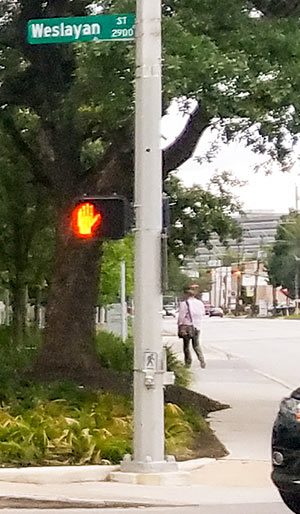 Reader Adam Goss, who identifies himself as a Houstonian — and a graduate of Wesleyan University in Connecticut — writes that it “drives him insane” that “the street named after our alma mater is misspelled. All the surrounding streets are named after similar universities and colleges (Amherst, Oberlin, Georgetown), yet for some reason the largest of all, Weslayan, is spelled incorrectly.
How would Rice grads like it if a major thoroughfare in Chicago was named after the famed Houston university, Rize Avenue. Or if Boston named a major street Longhornes, after a famed UT alum?”
Photo of street sign at the corner of Weslayan and W. Alabama St.: Jeremy Hughes
Reader Adam Goss, who identifies himself as a Houstonian — and a graduate of Wesleyan University in Connecticut — writes that it “drives him insane” that “the street named after our alma mater is misspelled. All the surrounding streets are named after similar universities and colleges (Amherst, Oberlin, Georgetown), yet for some reason the largest of all, Weslayan, is spelled incorrectly.
How would Rice grads like it if a major thoroughfare in Chicago was named after the famed Houston university, Rize Avenue. Or if Boston named a major street Longhornes, after a famed UT alum?”
Photo of street sign at the corner of Weslayan and W. Alabama St.: Jeremy Hughes
COMMENT OF THE DAY: AREN’T THESE THE HEIGHTS DESIGN GUIDELINES WE’VE BEEN ASKING FOR? 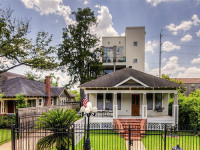 “Here we go again with the sky-is-falling BS on the historic ordinance. For years, the builders have whined about how they needed a design guide for the Heights. HAHC takes 2 years to collect input from the HDs [historic districts] on design guidelines. There were many meetings, direct mailings, surveys and even direct invitations from Steph McDougal to have one-on-one meetings with stakeholders to discuss the design guidelines. The response HAHC got from the HDs was that we are sick and tired of builders trying to fill every lot with gratuitous square footage. Additions are fine, but building a 3300-sq.-ft. house behind a bungalow is atrocious. And stop with the BS about families. Families do not need giant houses. They need affordable houses. Every time I talk with a family about moving to the Heights they always say that they have been priced out because everything is so huge and expensive.” [Old School, commenting on June Is Your Last Chance To Make Noise In Person About the New Heights Historic District Design Guidelines] Photo of 519 Heights Blvd.: HAR
“Here we go again with the sky-is-falling BS on the historic ordinance. For years, the builders have whined about how they needed a design guide for the Heights. HAHC takes 2 years to collect input from the HDs [historic districts] on design guidelines. There were many meetings, direct mailings, surveys and even direct invitations from Steph McDougal to have one-on-one meetings with stakeholders to discuss the design guidelines. The response HAHC got from the HDs was that we are sick and tired of builders trying to fill every lot with gratuitous square footage. Additions are fine, but building a 3300-sq.-ft. house behind a bungalow is atrocious. And stop with the BS about families. Families do not need giant houses. They need affordable houses. Every time I talk with a family about moving to the Heights they always say that they have been priced out because everything is so huge and expensive.” [Old School, commenting on June Is Your Last Chance To Make Noise In Person About the New Heights Historic District Design Guidelines] Photo of 519 Heights Blvd.: HAR
COMMENT OF THE DAY: NOSTALGIA FOR THE EARLY HISTORY OF THE HISTORICAL HEIGHTS BUILDING GUIDELINES  “The big problem isn’t just the restriction on the size of the addition, it’s how they will allow you to add the square footage. Instead of allowing you to build out your attic with dormers, or do an addition on top of the back half of the house, they want you to basically build a new historically incompatible structure in your existing back yard and connect it to the house through some little hallway which will look like crap, AND use up your yard/permeable surface, AND create a structure looming over your neighbors’ backyards. The first year or 2 of the historic district, things worked pretty well in regards to stopping teardown and allowing responsible additions. Then it all went off the rails.”
[Arlington Gal, commenting on June Is Your Last Chance To Make Noise In Person About the New Heights Historic District Design Guidelines] Illustrations of Heights houses: Dalia Rihani
“The big problem isn’t just the restriction on the size of the addition, it’s how they will allow you to add the square footage. Instead of allowing you to build out your attic with dormers, or do an addition on top of the back half of the house, they want you to basically build a new historically incompatible structure in your existing back yard and connect it to the house through some little hallway which will look like crap, AND use up your yard/permeable surface, AND create a structure looming over your neighbors’ backyards. The first year or 2 of the historic district, things worked pretty well in regards to stopping teardown and allowing responsible additions. Then it all went off the rails.”
[Arlington Gal, commenting on June Is Your Last Chance To Make Noise In Person About the New Heights Historic District Design Guidelines] Illustrations of Heights houses: Dalia Rihani
JUNE IS YOUR LAST CHANCE TO MAKE NOISE IN PERSON ABOUT THE NEW HEIGHTS HISTORIC DISTRICT DESIGN GUIDELINES 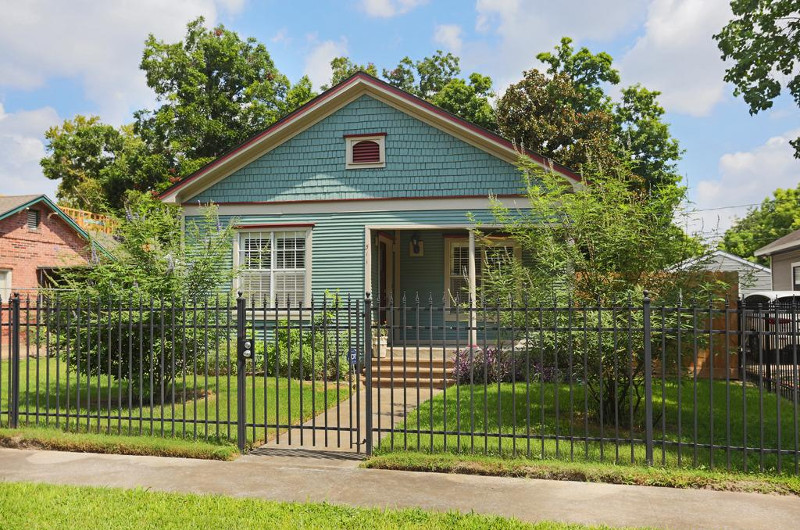 As of this evening, the Heights-applicable design guidelines being presented at the public meeting planned for June aren’t posted on the City’s website yet, but they purportedly will be by the end of next week. In the meanwhile, Jonathan McElvy has a rundown of some of the proposed rules, which he suggests in the Leader today has shifted his view of the codification process from a cause for celebration (no more seemingly arbitrary denials of that raised eave that looks just like your neighbor’s!) to a potential cause for concern — particularly for those hoping to populate the neighborhood with families wanting to add on to their bungalows. “What should frighten people the most in the Heights,” writes McElvy, is that “the proposed guidelines say that if you have a 6,600-square-foot lot, your home can be no more than 2,700 square feet. If you have a 5,000-square-foot lot, your home can be no larger than 2,200 square feet“ — including garage and porch square footage. If you’ve got an opinion about that, the meeting will be on June 20th at the Heights Fire Station from 6 to 8. [The Leader; previously on Swamplot] Photo of 511 E. 24th St.: HAR
As of this evening, the Heights-applicable design guidelines being presented at the public meeting planned for June aren’t posted on the City’s website yet, but they purportedly will be by the end of next week. In the meanwhile, Jonathan McElvy has a rundown of some of the proposed rules, which he suggests in the Leader today has shifted his view of the codification process from a cause for celebration (no more seemingly arbitrary denials of that raised eave that looks just like your neighbor’s!) to a potential cause for concern — particularly for those hoping to populate the neighborhood with families wanting to add on to their bungalows. “What should frighten people the most in the Heights,” writes McElvy, is that “the proposed guidelines say that if you have a 6,600-square-foot lot, your home can be no more than 2,700 square feet. If you have a 5,000-square-foot lot, your home can be no larger than 2,200 square feet“ — including garage and porch square footage. If you’ve got an opinion about that, the meeting will be on June 20th at the Heights Fire Station from 6 to 8. [The Leader; previously on Swamplot] Photo of 511 E. 24th St.: HAR
COMMENT OF THE DAY: THE NEXT ASTRODOME ELECTION IS ALREADY SCHEDULED, ANYWAY  “Great to see that a bill specifically tailored to torpedo the Astrodome has been shot down. The state politicians should not meddle in local county affairs. Did anyone ever ask Houston and Harris County voters to spend millions upon millions to host another Super Bowl? Or to upgrade Reliant Stadium to please McNair? If the county’s financing plan is legitimate (no bonds issued, and a referendum not required), let them continue. Harris county voters have already spoken by voting Emmett and others in. They’ll have their chance to vote them out if needed. The revitalized Dome could be something special — why waste a unique structure and a Houston landmark?” [Blake, commenting on The Bill To Force an Astrodome Garage-ification Election Is Dead, Again, For Now] Illustration: Lulu
“Great to see that a bill specifically tailored to torpedo the Astrodome has been shot down. The state politicians should not meddle in local county affairs. Did anyone ever ask Houston and Harris County voters to spend millions upon millions to host another Super Bowl? Or to upgrade Reliant Stadium to please McNair? If the county’s financing plan is legitimate (no bonds issued, and a referendum not required), let them continue. Harris county voters have already spoken by voting Emmett and others in. They’ll have their chance to vote them out if needed. The revitalized Dome could be something special — why waste a unique structure and a Houston landmark?” [Blake, commenting on The Bill To Force an Astrodome Garage-ification Election Is Dead, Again, For Now] Illustration: Lulu
NICE PARK IF YOU CAN GET TO IT, AND OTHER HOUSTON ENCAPSULATIONS 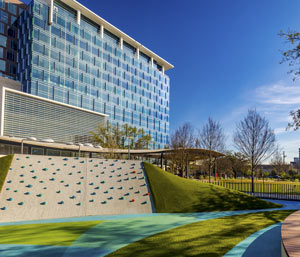 George Ristow’s take for OffCite on the recently unveiled public-private redo of Levy Park? It’s become “one of Houston’s best outdoor public spaces” — as long as you can get yourself there: “The park is tucked away from view, dwarfed by the Kirby Grove building, which undermines its connection [to] Richmond Ave. (bringing visitors from Upper Kirby). Although there are sidewalks immediately surrounding the park, no sidewalk exists on either side of Eastside St. between the park and Richmond. Just one block south of the park, the Southwest Freeway, with a right-of-way as wide as the park itself, walls off West University’s upper reaches as if it were an international border crossing. Consider the Olive Garden restaurant, surrounded by a typical suburban parking lot, built within the same time period as the Levy Park facelift just on the other side of the freeway. Here we have Houston in a nutshell: a state-of-the-art destination public park next to a 19-lane freeway next to a chain restaurant, with no way to walk between them.” [OffCite; previously on Swamplot] Photo: Levy Park Conservancy
George Ristow’s take for OffCite on the recently unveiled public-private redo of Levy Park? It’s become “one of Houston’s best outdoor public spaces” — as long as you can get yourself there: “The park is tucked away from view, dwarfed by the Kirby Grove building, which undermines its connection [to] Richmond Ave. (bringing visitors from Upper Kirby). Although there are sidewalks immediately surrounding the park, no sidewalk exists on either side of Eastside St. between the park and Richmond. Just one block south of the park, the Southwest Freeway, with a right-of-way as wide as the park itself, walls off West University’s upper reaches as if it were an international border crossing. Consider the Olive Garden restaurant, surrounded by a typical suburban parking lot, built within the same time period as the Levy Park facelift just on the other side of the freeway. Here we have Houston in a nutshell: a state-of-the-art destination public park next to a 19-lane freeway next to a chain restaurant, with no way to walk between them.” [OffCite; previously on Swamplot] Photo: Levy Park Conservancy
COMMENT OF THE DAY: HOUSTON’S CRUMBLING SUPER BOWL SOUVENIRS  “. . . I think pretty much everyone has long forgotten that we had a Super Bowl here. That memory is tossed out like an empty bag of chips. $347 million was allegedly pumped into our economy, and all I got was some quick fills of some potholes.” [Super Bowl Memories, commenting on Super Bowl LI’s Economic Impact in Houston; Expanding Metro’s Reach; previously on Swamplot] Photo of George R. Brown Convention Center before Super Bowl LI: Jesus Jimenez via Swamplot Flickr Pool
“. . . I think pretty much everyone has long forgotten that we had a Super Bowl here. That memory is tossed out like an empty bag of chips. $347 million was allegedly pumped into our economy, and all I got was some quick fills of some potholes.” [Super Bowl Memories, commenting on Super Bowl LI’s Economic Impact in Houston; Expanding Metro’s Reach; previously on Swamplot] Photo of George R. Brown Convention Center before Super Bowl LI: Jesus Jimenez via Swamplot Flickr Pool
COMMENT OF THE DAY: DESTROY MY SEMI TRAILER ON N. MAIN ST. ONCE, SHAME ON ME  “I’d bet that the signage, 12′-9″, is probably literally correct, in that the distance from the road deck to the bottom of the bridge measures 12′-9″. However, that doesn’t mean that a truck that’s 12′-8″ high can pass through. More to the point: that doesn’t mean a truck that’s 12′-8″ high can exit the other end. Problem is that since there’s an up-slope on the exit of the underpass, the longer the truck, the higher the effective height as it climbs up the slope. [And] with respect to the alternate route, the northbound signage is terrible. It seems to indicate that the driver should turn left into a chain link fence. Where they actually should go looks like its one-way the other way. If this happens once, I understand blaming the driver. If it happens frequently, it’s probably the result of poor design and poor signage.” [Angostura, commenting on Latest Semi To Get Stuck in that N. Main Tunnel by Hardy Yards Gets Top Shredded Off, Too] Photo: TransitCtrActivity
“I’d bet that the signage, 12′-9″, is probably literally correct, in that the distance from the road deck to the bottom of the bridge measures 12′-9″. However, that doesn’t mean that a truck that’s 12′-8″ high can pass through. More to the point: that doesn’t mean a truck that’s 12′-8″ high can exit the other end. Problem is that since there’s an up-slope on the exit of the underpass, the longer the truck, the higher the effective height as it climbs up the slope. [And] with respect to the alternate route, the northbound signage is terrible. It seems to indicate that the driver should turn left into a chain link fence. Where they actually should go looks like its one-way the other way. If this happens once, I understand blaming the driver. If it happens frequently, it’s probably the result of poor design and poor signage.” [Angostura, commenting on Latest Semi To Get Stuck in that N. Main Tunnel by Hardy Yards Gets Top Shredded Off, Too] Photo: TransitCtrActivity
A CHECK ON EXPIRATION DATES AMID THE HEIGHTS FOODIE BOOM 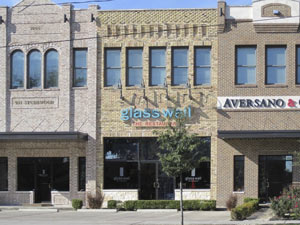 The restaurant–heavy redevelopment of various used car dealerships and auto shops along N. Shepherd Dr. might bring with it some future trouble for the Heights area, Jonathan McElvy suggests in his column for the Leader this week. McElvy worries that too many new spots chasing after trends in the “culinary preferences of Houston’s red-hot foodie community,” (as he notes recently closed-for-re-concepting Heights restaurant Glass Wall described it) may mean that the area is “about to enter a period of constant turnover along our most important corridor.” Noting the startling estimates on how many restaurants close in fewer than 5 years (whether due to lack of business knowledge, bad construction traffic, or sheer bad luck), McElvy writes that while there’s little to be done to curb the popularity of “farm-to-table restaurants that know how to plate a dish but don’t have a clue how to pay franchise taxes on time . . . it is not going to help our community if 1 business opens and another closes every other week.” [The Leader; previously on Swamplot] Photo: Karen S.
The restaurant–heavy redevelopment of various used car dealerships and auto shops along N. Shepherd Dr. might bring with it some future trouble for the Heights area, Jonathan McElvy suggests in his column for the Leader this week. McElvy worries that too many new spots chasing after trends in the “culinary preferences of Houston’s red-hot foodie community,” (as he notes recently closed-for-re-concepting Heights restaurant Glass Wall described it) may mean that the area is “about to enter a period of constant turnover along our most important corridor.” Noting the startling estimates on how many restaurants close in fewer than 5 years (whether due to lack of business knowledge, bad construction traffic, or sheer bad luck), McElvy writes that while there’s little to be done to curb the popularity of “farm-to-table restaurants that know how to plate a dish but don’t have a clue how to pay franchise taxes on time . . . it is not going to help our community if 1 business opens and another closes every other week.” [The Leader; previously on Swamplot] Photo: Karen S.
COMMENT OF THE DAY: HOW LONG UNTIL HOUSTON’S FLOODWATERS WASH AWAY THE OIL MONEY?  “But hey, why bother [with impermeable ground cover]? I’m sure this city will continue to grow and prosper and the taxes will still come pouring in, years after it exacerbates its reputation as a flooded-out mess far behind the tipping point. It will make our elected leaders look so smart when the pension system fails anyway because energy companies choose to move to Austin, OKC, DFW and Denver, because they can’t in good conscience relocate people to the flooded mess of our city. Oh wait — you say energy companies would never leave Houston? Remember, the oil companies fled New York decades ago. Recently BP has moved its onshore group to Denver. Exxon is gone to the Woodlands (and lets not pretend that didn’t have anything to do with escaping the hot mess of city hall mismanagement.)” [Tired of flooding, commenting on Where 2 New Buildings and 542 New Surface Parking Spots Could Fit North of Washington Ave.] Illustration: Lulu
“But hey, why bother [with impermeable ground cover]? I’m sure this city will continue to grow and prosper and the taxes will still come pouring in, years after it exacerbates its reputation as a flooded-out mess far behind the tipping point. It will make our elected leaders look so smart when the pension system fails anyway because energy companies choose to move to Austin, OKC, DFW and Denver, because they can’t in good conscience relocate people to the flooded mess of our city. Oh wait — you say energy companies would never leave Houston? Remember, the oil companies fled New York decades ago. Recently BP has moved its onshore group to Denver. Exxon is gone to the Woodlands (and lets not pretend that didn’t have anything to do with escaping the hot mess of city hall mismanagement.)” [Tired of flooding, commenting on Where 2 New Buildings and 542 New Surface Parking Spots Could Fit North of Washington Ave.] Illustration: Lulu
RESIDENTS NEAR SMART FINANCIAL CENTRE: DON’T WANNA LIVE WITH ‘EM, MAYBE CAN’T LIVE WITHOUT ‘EM  Mike Snyder reports from a dead empty plaza at the new Smart Financial Centre in Sugar Land for the Chronicle this week — utilizing the deserted backdrop for some quiet contemplation and speculation regarding the development’s likely ability to draw long-term business. So-called “destination center” projects like Smart Centre and Town Square are “a big part of [Sugar Land’s] long-term financial strategy to broaden our economic base and keep our property taxes low,” city business director Jennifer Mays tells Snyder — but Snyder and others suggest that a lack of nearby residential development may make it harder for Smart Centre to take off the way Town Square has. Snyder also notes that 900 new apartments were originally planned near Smart Centre, but were nixed on account of objections from “residents concerned that renters would increase traffic, crowd schools and damage their suburban lifestyle.” [Houston Chronicle; previously on Swamplot] Photo: Smart Financial Centre
Mike Snyder reports from a dead empty plaza at the new Smart Financial Centre in Sugar Land for the Chronicle this week — utilizing the deserted backdrop for some quiet contemplation and speculation regarding the development’s likely ability to draw long-term business. So-called “destination center” projects like Smart Centre and Town Square are “a big part of [Sugar Land’s] long-term financial strategy to broaden our economic base and keep our property taxes low,” city business director Jennifer Mays tells Snyder — but Snyder and others suggest that a lack of nearby residential development may make it harder for Smart Centre to take off the way Town Square has. Snyder also notes that 900 new apartments were originally planned near Smart Centre, but were nixed on account of objections from “residents concerned that renters would increase traffic, crowd schools and damage their suburban lifestyle.” [Houston Chronicle; previously on Swamplot] Photo: Smart Financial Centre

